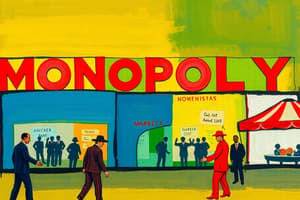Podcast
Questions and Answers
What characterizes a monopolist in a market?
What characterizes a monopolist in a market?
- Operates without any barriers to entry.
- Has multiple sellers competing for customers.
- Sets prices based on market forces.
- Is the only seller with no close substitutes. (correct)
Which of the following is a barrier to entry in a monopolistic market?
Which of the following is a barrier to entry in a monopolistic market?
- An oversaturated market.
- High consumer demand.
- Diversity in product offerings.
- Government regulations granting exclusivity. (correct)
What does it mean for a monopolist to be a 'price maker'?
What does it mean for a monopolist to be a 'price maker'?
- It follows the market price set by competitors.
- It has the ability to set prices independently of market demand. (correct)
- It cannot influence prices due to market saturation.
- It must price its product below competitors to attract buyers.
Which of the following is NOT considered a type of monopoly resource?
Which of the following is NOT considered a type of monopoly resource?
What is an example of economies of scale in a monopolistic market?
What is an example of economies of scale in a monopolistic market?
Which of the following statements about monopolies is false?
Which of the following statements about monopolies is false?
Which characteristic is essential for a market to be classified as a monopoly?
Which characteristic is essential for a market to be classified as a monopoly?
What can lead to a firm achieving monopoly status in the market?
What can lead to a firm achieving monopoly status in the market?
What is the elasticity of demand for the monopolist's product, given that a 10 percent price decrease leads to a 5 percent increase in total revenue?
What is the elasticity of demand for the monopolist's product, given that a 10 percent price decrease leads to a 5 percent increase in total revenue?
At what price should the monopolist charge to maximize profits if the marginal cost is 10 baht and elasticity is 1.5?
At what price should the monopolist charge to maximize profits if the marginal cost is 10 baht and elasticity is 1.5?
How does the pricing of generic drugs compare to that of monopolist drugs in the pharmaceutical market?
How does the pricing of generic drugs compare to that of monopolist drugs in the pharmaceutical market?
What percentage change in total revenue occurs from a 10 percent decrease in price for the monopolist?
What percentage change in total revenue occurs from a 10 percent decrease in price for the monopolist?
In a monopoly, the monopolist sets the price in relation to which of the following?
In a monopoly, the monopolist sets the price in relation to which of the following?
What is the relationship between marginal revenue and price for a monopoly?
What is the relationship between marginal revenue and price for a monopoly?
Which effect contributes to an increase in total revenue when quantity sold increases?
Which effect contributes to an increase in total revenue when quantity sold increases?
If a monopoly increases production, what happens to the price of the good?
If a monopoly increases production, what happens to the price of the good?
What does the demand curve represent in the context of a monopoly?
What does the demand curve represent in the context of a monopoly?
Why is the marginal revenue curve below the demand curve for a monopoly?
Why is the marginal revenue curve below the demand curve for a monopoly?
What occurs when the price effect of increasing production dominates the output effect?
What occurs when the price effect of increasing production dominates the output effect?
In a monopolistic market, what can be inferred about the relationship between total revenue and output when marginal revenue is less than price?
In a monopolistic market, what can be inferred about the relationship between total revenue and output when marginal revenue is less than price?
What is a primary condition necessary for price discrimination to occur?
What is a primary condition necessary for price discrimination to occur?
What happens to the marginal revenue of a monopoly as the quantity of the good sold increases?
What happens to the marginal revenue of a monopoly as the quantity of the good sold increases?
Which of the following strategies is an example of price discrimination?
Which of the following strategies is an example of price discrimination?
In a scenario where different groups of buyers have varying price elasticity of demand, which group is likely to pay a higher price?
In a scenario where different groups of buyers have varying price elasticity of demand, which group is likely to pay a higher price?
What is a critical factor that prevents resale of tickets among different buyer groups under price discrimination?
What is a critical factor that prevents resale of tickets among different buyer groups under price discrimination?
Which of the following is NOT a method to increase competition against monopolies?
Which of the following is NOT a method to increase competition against monopolies?
What is one common regulatory response to natural monopolies?
What is one common regulatory response to natural monopolies?
In public policy towards monopolies, what is the term for splitting a large company into smaller entities?
In public policy towards monopolies, what is the term for splitting a large company into smaller entities?
Which of the following is an example of quantity discount as a form of price discrimination?
Which of the following is an example of quantity discount as a form of price discrimination?
What negative consequence can arise from a lack of efficient management in public ownership?
What negative consequence can arise from a lack of efficient management in public ownership?
Which of the following options best describes a product with inelastic demand?
Which of the following options best describes a product with inelastic demand?
What relationship does the formula $MR = P (1 - \frac{1}{\epsilon}) = MC$ illustrate?
What relationship does the formula $MR = P (1 - \frac{1}{\epsilon}) = MC$ illustrate?
When a firm sets its price, under what condition does it ensure a positive marginal revenue?
When a firm sets its price, under what condition does it ensure a positive marginal revenue?
What does the price markup formula $P = \frac{\epsilon}{\epsilon - 1} \cdot MC$ imply regarding pricing strategy?
What does the price markup formula $P = \frac{\epsilon}{\epsilon - 1} \cdot MC$ imply regarding pricing strategy?
How is the profit margin, or Lerner Index, defined in the formula $L = \frac{P - MC}{P}$?
How is the profit margin, or Lerner Index, defined in the formula $L = \frac{P - MC}{P}$?
In the context of elasticity, why is the negative sign in price elasticity often ignored in the equations?
In the context of elasticity, why is the negative sign in price elasticity often ignored in the equations?
Why might a firm choose to operate where demand elasticity is greater than 1?
Why might a firm choose to operate where demand elasticity is greater than 1?
What type of product would most likely be oriented towards a pricing strategy where elasticity is less than 1?
What type of product would most likely be oriented towards a pricing strategy where elasticity is less than 1?
What does it mean for a firm to be a price maker in terms of demand elasticity?
What does it mean for a firm to be a price maker in terms of demand elasticity?
Flashcards are hidden until you start studying
Study Notes
Monopoly
- A single seller of a product without close substitutes
- A monopolist is a price maker
- The monopolist has barriers to entry.
Barriers To Entry
- Government regulations.
- Monopoly resources (a company has unique access to resources).
- Technology (technology can make the cost of production lower than all other companies).
- Economies of scale (efficiency and lower costs due to large production).
Marginal Revenue (MR)
- MR < P
- Marginal revenue curve is below the demand curve
- If the monopoly increases production, the price on all units sold must fall, therefore marginal revenue is always less than the price.
Relationship Between MR and Elasticity
- MR = P (1 − 1/ ε) = MC
- The firm sets its own price and will set the price where demand is elastic (elasticity >1) to ensure a positive marginal revenue.
Pricing Formula
- Price Mark Up formula:
- P=(ε/(ε−1)).MC
- Profit Margin (Lerner Index):
- (P-MC)/P = L = 1/ε, where ε > 1
Monopoly Drugs versus Generic Drugs
- The production of generic drugs creates a competitive market.
- Generic drugs are produced where MR = MC and P = MC
- Generic drug prices are below the monopolist's price.
Price Discrimination
- Examples of price discrimination:
- Movie tickets.
- Airline prices.
- Discount coupons.
- Financial aid.
- Quantity discounts.
- Conditions for price discrimination:
- Monopoly power.
- Different price elasticity of demand for different buyers.
- No re-sales among different groups of buyers.
Public Policy Toward Monopolies
- Increasing competition with antitrust laws:
- Prevent mergers.
- Break up companies.
- Prevent companies from coordinating their activities to make markets less competitive.
- Regulation: price control
- Common in case of natural monopolies.
- Public ownership.
- If it does a bad job, losers are the customers and taxpayers.
Studying That Suits You
Use AI to generate personalized quizzes and flashcards to suit your learning preferences.




